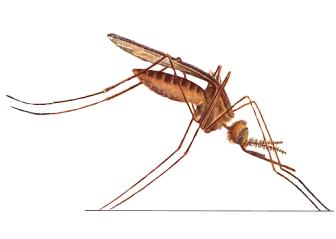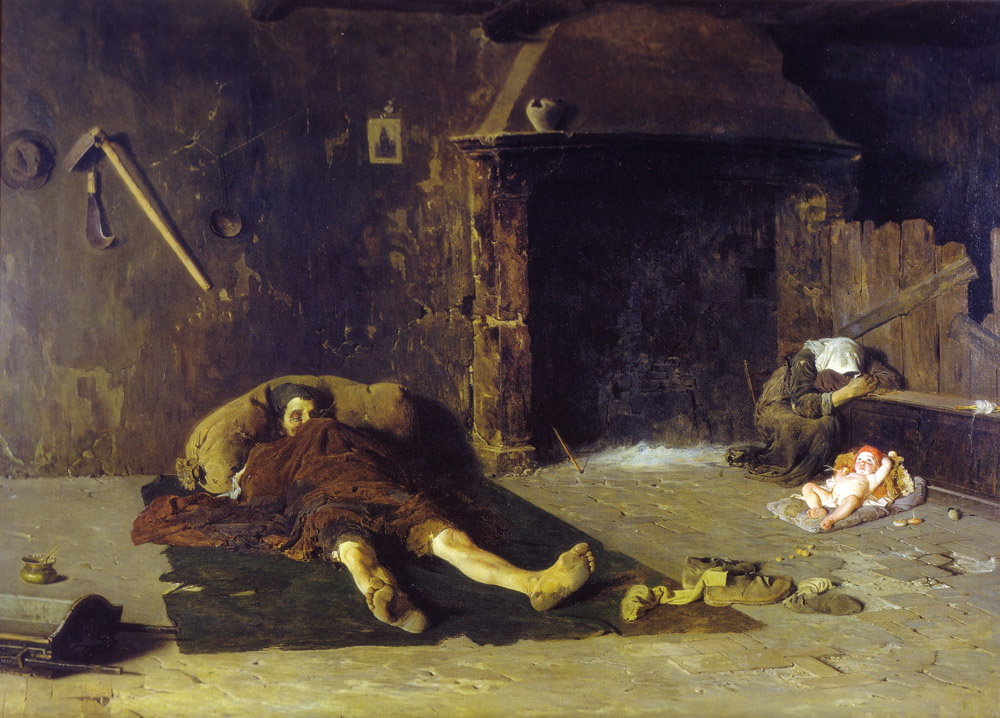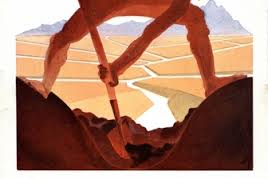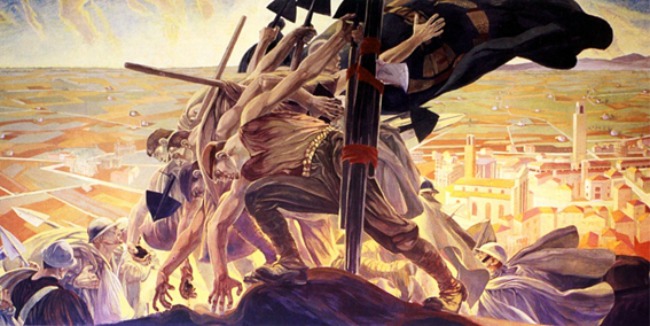MIASMA AND MOSQUITOS: An ancient Roman curse
Several Roman harbor an exaggerated fear of drafts, few of them dare to sleep with an open window open and as soon as the air is saturated with moisture and cold they cover themselves up with layers of clothing and scarves and only reluctantly leave their overly heated homes, cars and offices.
In Rome, fear of miasma is still alive, the moldy decayed fumes that allegedly seep out of the Eternal City's decaying guts. Almost imperceptibly they penetrate the porous soil and Rome's soft limestone; the tuff and the travertine. Moisture and rot from vast systems of catacombs long forgotten and brooding on ancient accumulations of dead bodies, rats and other vermin. Rotten stench from broken-down sewers, unexplored caves, built-over swamps and underground rivers where all kind of uncleanness thrive. Superstitious children and adults spread stories about spirits and ghosts, who along with the miasma rise up from the earth to paralyze the living with their icy touch, kill them and bring them back with them to their abode down below, the Aldilá, "There Beyond".

I have often been reminded of the miasma´s presence. Guide books from the nineteenth and early twentieth century alerted visitors to Rome about its harmful effects. It was, for instance, not recommended to travel in an open carriage after sunset. When the warmth of the sun no longer depressed the cold of the underworld, harmful vapors rose out of the ground, the movements of wagons and horses swirled up fumes of disease and putrefaction, which found their way into the carriage passengers' lungs. It was not healthy to linger in wrong places, at the wrong time of the year and at the wrong time of day. Especially dangerous was it after dusk in the vicinity of archaeological sites. I thought about it one evening when I along with my family attended a performance of Aida in the huge ruins of the Baths of Caracalla, suddenly we all felt how gushes of raw, cold and moisture-laden air found their way under the pews and spilled over into the surroundings - it was the miasma that was wafting out from the hidden depths beneath us.
Rome was for thousands of years known as an unhealthy place. As soon as their duties permitted it, wealthy Romans who lived during the era of classical antiquity escaped their town and made their way up to the fresh air around their rural villas in the hillcountry, or moved down to the shores of the Tyrrhenian Sea. In the eleventh century Peter Damian, bishop of Ostia, wrote, "Rome devourer of men, tames the erect necks of men. Rome fruitful in fevers is very rich in the harvest of death. The Roman fevers are faithful to a constant law. Once they have assailed a person, they seldom leave him while he is still alive."
Within the walls of Rome, water is always present. Aron Borelius, my professor of art history, once told me: "I'm a very old man. Do you want to know how old I am? I'm so old that when I was a young man youth strolling through Rome´s streets in the night, I could all the time hear the sound of rippling water." He meant that in his youth there was almost no car traffic in Rome, and in the stillness of the night the purling of water could be heard everywhere because the wealth of city fountains and nasos, noses, the drinking water fountains that still can be encountered in several of the city's street corners, where they constantly pour water from their “noses”, i.e. long, bent iron taps.

If you descend deep under the Basilica of San Clemente, near the Colosseum, you will hear how one of Rome's underground rivers unseen gushes forth under your feet. All this water has for thousands of years been pouring down into the Tiber. Crumbling sewers and old pipes have for years and years, in reckless disregard for public health, spewed their waste into the shallow Tiber. A river that on top of this misery regularly overflowed its banks to spread devastation, disease and death.

Italy's great folk hero Giuseppe Garibaldi had been bothered by this state of affairs and in 1875 he left his self-imposed exile on the island of Caprera off the Sardinian coast to return to Rome and as a member of the Chamber of Deputies combat the malaria (mal - bad, aria - air). Garibaldi suggested that the river bed simply had to be filled in, while the Tiber´s course could be altered in such a manner that it passed by outside of the city. In order to increase the prosperity and well-being of the kingdom's new capital, Garibaldi also wanted to drain the huge marshes south of the town and turn them into cornfields. The Tiber was saved from being obliterated; instead ‒ beginning in 1876 ‒ huge embankments were constructed along the river shores, separating the Tiber from the surrounding city. The pictures below provide a clear picture of how these high walls protect the city from being flooded, observe how the sidewalks become inundated during aqua alta, high water.


The people living at Garibaldi's time did not yet know that malaria was spread by a mosquito, but continued to blame the disease on bad air coming from polluted, stagnant water. Many assumed that people who lived in vapors from such water ran the risk of succumbing to hopelessness and fatal lethargy. Garibaldi, and others with him, feared that many Romans due to the unhealthy exhausts had broken down and become part of a deformed, degenerate and stupid generation.
Society had stagnated, a word derived from the Latin term for a puddle ‒ stagnum. Swamps were perceived by many as extremely harmful and in some circles such bodies of water were likened to "femininity", while healthy, vigorously flowing water was considered to be "masculine".
In his fascinating book Male Fantasies Klaus Theweleit describes how swamps in Fascist and Nazi ideologies sometimes came to symbolize a “female” threat to the male body's hardness, dryness and insensitivity. The women's world was described as soft, malleable and wet. If an object falls into a swamp it is absorbed, it sinks into it, while the surface again becomes calm. Like quicksand “the feminine” is both solid and liquid, it is also impure and deadly, not creative, only encompassing, it is cool, but flaccid and devouring. Strange notions like these fitted like a glove for virile Fascists while they set out to drain the Pontine Marshes, leading the water from female, stagnant pools into the masculine gushing Mussolini Canal that flowed into the Tyrrhenian Sea.
More of this later on – let us now turn to the mosquitoes, a kind of insect that hardly can hardly be called neither soft, nor passive, it is namely the mosquito female which sucks blood and produce offspring, whereas male mosquitos are quite irrelevant creatures.
I am writing this in the garden of our house in Bjärnum. A rather stupid initiative since the blinding sunshine means that I can barely see the computer screen, but I cannot stay inside now when nature flaunts its lush and healthy greenery, the sun is warm and the birds are still singing, soon they will fall silent while they are getting busy attending to their young. Just now I caught a mosquito and am scrutinizing this tiny, but nasty animal. It was such a creature that that was the source of the Roman malaria, it was she and not any bad air that was the real culprit.
It was until in 1898 when three Italian scientists, Grassi, Bignami and Bastianelli, managed to prove that malaria was caused by a single-celled organism which was spread by anopheles, a specific species of mosquito. They are found worldwide. Even in Sweden anopheles once spread the malaria, which up in the North was called chills or swamp fever. It came in the form of violent shaking shock, sudden attacks of fever, nausea, vomiting, headaches, diarrhea, and muscle aches.

I observe the mosquito while she is carefully advancing across my fore arm. As soon as she starts to suck blood I will slap her dead. With the naked eye I cannot discern her refined weapons; a bouquet of seven spears that pierce through the victim's skin, before she through a snout sucks up the blood. Her proboscis contains both inward- and outward conducting channels. She must before she sucks up the blood inject her saliva into the wound to hinder it from clotting. In her saliva live microscopic fungi that irritate the tissue and increase the blood flow at the same time as unicellular animals are released to poison the human body.
A proper sip of fresh blood stimulates the development of the mosquito´s eggs and when they are ready to hatch their mother places them in stagnant water, where they become larvae that incessantly swim around with frenzied, jerky movements in search of microscopic plankton, before they become pupae, and finally leave the water as fully developed, blood-sucking mosquitoes. To survive, the mosquito larvae need oxygen and heat. That means they will die if the water surface is coated by, for example, oil. In a cold environment, like in Northern Sweden, mosquito larvae live close to the surface of small pools of stagnant water, precisely because these are rapidly heated by the sun and lack predators like fish and larger insects. In a warmer climate mosquito larvae thrive in deeper waters, like swamps, where the water is warm and tranquil. In Italy, the mosquitos enjoyed the huge Pontine Marshes south of Rome.
My father often had time for me and as far back as I can remember we used to talk to each other like two friends. I do not remember that my father ever treated me like a feeble-minded child. As I got older, he could even confess mistakes he had made as a young man. For example, he once told me that: "I have seldom felt so ashamed as when I discovered that Mussolini was a bloated and phony despot and that Fascism in reality was a quite harmful ideology. As a youngster, I had been quite impressed by what happened in Italy. I was probably under the influence of older friends and acquaintances. "
In those days I had already seen movies with goose marching Black Shirts and the buffoon-like Mussolini who shot out his chin while he made stupid faces and theatrical gestures. He had waged war on Hitler's side and eventually ended up with his own people in arms against him. How could my father have been able to admire such a clown? "It was about cooperation, modernization and notions that at the time seemed to be modern, fresh and innovative. Foremost it was the successful drainage of the Pontine Marshes that impressed me. The Fascists succeeded in eradicating the malaria. We imagined they were about to overcome the endemic poverty of Italy. But in 1935 they attacked Ethiopia with airplanes pouring poison gas over defenseless peasants and thus I became convinced that most of the advertised successes had been nothing more than mendacious propaganda. "
All that was new to me and it was only when I had moved to Italy and began to notice some similarities between Swedish Social Democracy and early Fascism that I began to understand what my father had hinted at. I also started taking an interest in the Pontine Marshes.
The vast marshes south of Rome had been formed when large sandy plains prevented the waters from the Volscian and Albanian hills to reach the sea. Even if they protected the southern flank of Rome the marshes also had to be traversed by Roman troops heading south and to that end the tree-lined Appian Road was constructed straight through the marshes. The road was a constant hassle, wide channels had to be dug and constantly dredged to protect and clear it from floods. Many soldiers marching along Via Appia and the slaves who maintained it succumbed to the malaria, while wealthy Romans heading south preferred to take the sea route.

Even if the area was very fertile the malaria made it sparsely populated and empty, waterlogged plains alternated with large, untamed forests. Travelers like Goethe and H.C. Andersen praised the Pontina as one of Europe's most beautiful areas, though H.C. Andersen marveled at how the few inhabitants "were so pale and sick, with yellowed skin." It was the miasma that sucked the life out of them and poisoned their blood. During the nineteenth century the suffering and misery in the Pontine Marshes were depicted by several Roman artists, often as an effort to make the Romans conscious about the misery that reigned not far from the Eternal City´s southern walls and that it was under constant threat from the unhealthy vapors that caused so much misery in the marshes red from the South.

Princes, popes and cardinals succumbed to the malaria and it was not until the Jesuit Agostino Salumbrino in 1631 brought the miracle drug of the Quechuas to Rome. For centuries the quinine bark taken from a tree growing in Peru had successfully been used to kill the malaria spreading amoeba. When the effectiveness of quinine had been proven, Romans began to dream about defeating the ghosts of the Pontine Marshes. Many of them actually believed that miasma could take the form of evil spirits taking possession of human bodies. Forensic archaeologists have from Roman cemeteries unearthed corpses, diagnosed with malaria, that have been weighed down with stones as if the living wanted to confine the contaminating spirits still lingering within the dead and anchor them into the ground.

Quinine proved to be quite effective against malaria and it is said to have played a major role in colonialism. When the Spaniards, Frenchmen, Englishmen and other conquerors began to drink quinine, tropical countries ceased to be "the white man's grave". The British preferred to alleviate the bitter taste of quinine with gin and thus invented gin and tonic, which was enjoyed extensively by soldiers and colonial officials.
Supported by the wondrous quinine, workers could maybe drain and cultivate the Pontine Marshes. Even Goethe had in Faust's second part made the main character dream about converting the marshes into a huge area where millions could live, "if not entirely confident, however, free and active" and that was also Garibaldi's plan. However, the fear of miasma remained and no one dared to get to grips with the big task, at least not until it was found that it was neither evil spirits or rotten fumes that afflicted the marshes, but a tiny, seemingly insignificant mosquito.
In early 1922, the Italian Ministry of Health launched the first stage of its National Prevention Plan - free quinine was distributed to swamp residents and all those who would participate in the vast drainage work; houses were painted white and large screens were set up so the mosquitoes became visible and could be killed. People affected by malaria were isolated within large facilities and treated with quinine. If the malaria parasite was killed by quinine, newborn Anopheles mosquitos were not infected while sucking the blood from recovered malaria patients. Scientists identified the mosquitoes hatching places and poured grease or oil over the water, whereby stifling the larvae. Fortunately, DDT was not in use until 1938 and then the mosquito plague was largely under control.
When stage one of recuperating the marshes was up and running, the plans for the next stages were initiated - the actual draining of the swamps. Thousands of workers were sent into the marsh lands to build canals and dams so that the water could be used to irrigate the fields and directed towards the sea. When the irrigation needs were met, fields were cleared for the planting of the seed, while towns and villages were erected for farmers and service personnel.
It was probably Mussolini's great luck that all this began shortly before he and his Fascists came to power. Now he could leap up on the locomotive, which already had started to roll and turn himself to the people who enthusiastically followed him into the new adventure: "Italians" he thundered with his chin willfully prominent. "We have now started the huge battle that already Augustus dreamt of, which the great Garibaldi wanted to fight, but never was able to initiate. Supported by my Fascists and loyal management we are now waging a heroic battle against the marshes and this magnificent endeavor will be followed by the Battle for Wheat, when thousands of farmers will sow and reap, so that Italy finally becomes totally self-sufficient! "
The conquest of the Pontine Marshes became the battle cry of the Fascists, driving them forward and soon everything ran at a tremendous speed. Mussolini abolished freedom of the press and banned all other parties except his own. Homes, buildings and roads grew up all over Italy and the Mafia was disciplined. After a few years, the country's wheat crop had increased fivefold. Swamps were drained, forested areas cleared, while Mussolini, like the spaghetti on each family´s table, was everywhere - he was riding, fencing, running, swimming, playing the violin, skiing, writing bad plays, flew planes, harvested, screamed and yelled, all in the light from camera flashes and always at the center of adoring crowds.
"Mussolini is always right!" declared gigantic propaganda posters and the Leader´s grave face was seen in every corner of the vast country. Nevertheless, we know now how it all ended. Power drunk and blinded by his own magnificence Mussolini allowed his troops to kill defenseless Abyssinian peasants the poisonous gas and with such doubtful success attacked Yugoslavia, Albania and Greece that Germany and Austria were forced to step in to complete the whole sordid business. Mussolini lost control of himself, his politics and his people and fell into the stifling embrace of Hitler, ending up being humiliated by the little Austrian corporal whom he during his triumphal heyday had called "a plumber in a raincoat - a silly little clown". Mussolini sent Italians to die from cold and hunger in faraway Stalingrad, implemented racial laws, sending Jews to the extermination camps, was deposed by his own government and had to experience how his enemies invaded Italy and Italians taking arms against him. Finally, Mussolini's corpse hang upside down at a petrol station in Piazza Loreto in Milan, while most of his impoverished and humiliated compatriots rejoiced at the news of his death.
And the conquest of the Pontine Marshes? How did that immense endeavor end up? In early 1930, forests had been felled and over 16 000 square kilometers were covered by canals and trenches, harnessed rivers, dams and pumping stations. The Mussolini Canal had reached the Tyrrhenian Sea, at last bringing the water away from the pestilential swamps that gradually were turned into fertile fields. The project culminated in 1933, when it counted with 124 000 employees, though defaulting peasants and workers had been detained in overcrowded camps, surrounded by barbed wire. Wages were low, work days long, food and medical care poor and inadequate. The turnover of workers was unusually high. In 1935, all of them were dismissed without prior notice. Many of them were malaria infected.

The government had then placed over 2 000 families within the Pontine area, most of them came from the north and had certified their Fascist loyalty. Settlers were placed in the countryside and provided with standardized two-storey houses. Each family was also given a stable, an oven, a plow and other agricultural implements, some cows and several hectares of land, depending on soil quality and family size.
Five beautiful and well-planned cities were founded - Latina, Sabaudia, Pontine, Aprilia and Pomizia - all erected in an aesthetically pleasing, functionalist style. Outside these urban centers several smaller borghi, villages, were constructed. Malaria had almost disappeared and when the area was invaded by warring Germans and allied troops many farmers refused to evacuate their new homes and fertile fields.

When the Germans retreated they shut off the pumping stations and opened the dams so that the fields were covered with brackish water. They did it not only to destroy the agriculture and wipe out fresh water supply, they also wanted to frustrate the allied efforts to bring their tanks, trucks and heavy equipment towards Rome and the Germans also acted in full awareness of the fact that malaria mosquitoes thrive in brackish water. One of the disastrous consequences of the war was the outbreak of a fierce malaria epidemic, but finally – in 1962, Rome had its last case of malaria. A multi-millennial curse had been lifted and even if you still can feel the miasma creeping up out of the ground after sundown, it is not the same malaria, foul air, which had plagued the city for several thousand years.
You may read about Rome's fight against malaria in Pickering, Daniel (2005), Rome or Death: The Obsessions of General Garibaldi. London: Jonathan Cape. An Italian book about Mussolini's draining of the Pontine Marshes is Pennacchi, Antonio (2000), Palude. Storia d'amore, di spettri e trapianti. Roma: Donzelli. I read about mosquitoes in a Swedish book, Carl H. Lindroth's charming and well-crafted Från insekternas liv, but I am sure there are several excellent books in English about the Anopheles mosquito. Interesting ideas about Nazism and misogyny are presented by Klaus Theweleit in his Male Fantasies. Minneapolis: University of Minnesota Press, 1997. The town of Latina has an excellent and free of charge museum about life in the Pontine Marshes throughout time: Museo della terra Pontine.






